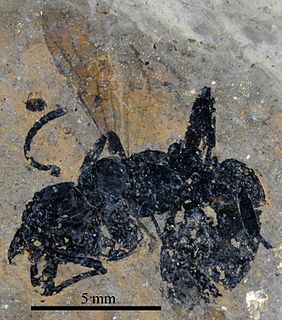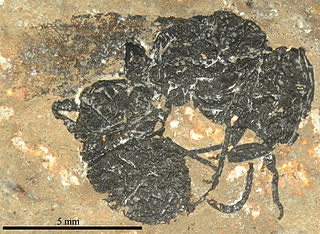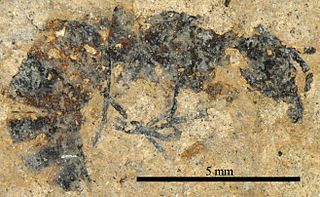
Formica is a genus of ants of the family Formicidae, commonly known as wood ants, mound ants, thatching ants, and field ants. Formica is the type genus of the Formicidae, and of the subfamily Formicinae. The type species of genus Formica is the European red wood ant Formica rufa. Ants of this genus tend to be between 4 and 8 mm long.

Ponerinae is a subfamily of ants in the Poneromorph subfamilies group, with about 1,600 species in 47 extant genera, including Dinoponera gigantea - one of the world's largest species of ant. Mated workers have replaced the queen as the functional egg-layers in several species of ponerine ants. In such queenless species, the reproductive status of workers can only be determined through ovarian dissections. Ponerinae is a subfamily of ants within the family of Formicidae. These ants typically nest in soil, forest litter, or rotting logs, and are predacious. They primarily prey on isopods. They mostly live in small colonies of up to 200 workers. They can be found mostly in tropical environments, but have been found in southeastern Canada and New York. Female workers have twelve segmented antennae, whereas male workers have 13 segmented antennae.

Myrmicinae is a subfamily of ants, with about 140 extant genera; their distribution is cosmopolitan. The pupae lack cocoons. Some species retain a functional sting. The petioles of Myrmicinae consist of two nodes. The nests are permanent and in soil, rotting wood, under stones, or in trees.

Liometopum is a genus of ants that belongs to the subfamily Dolichoderinae, found in North America, Europe and Asia.

Pachycondyla is a ponerine genus of ants found in the Neotropics.
Gesomyrmex curiosus is a species of ant in the subfamily Formicinae.
Gesomyrmex flavescens is a species of ant in the subfamily Formicinae.

Gesomyrmex germanicus is an extinct species of ant in the subfamily Formicinae known from an Eocene fossil found in Europe. G. germanicus is one of only eight species in the ant genus Gesomyrmex to have been described from fossils found in Europe.

Dolichoderus is a genus of ants found worldwide.

Ypresiomyrma is an extinct genus of ants in the subfamily Myrmeciinae that was described in 2006. There are four species described; one species is from the Isle of Fur in Denmark, two are from the McAbee Fossil Beds in British Columbia, Canada, and the fourth from the Bol’shaya Svetlovodnaya fossil site in Russia. The queens of this genus are large, the mandibles are elongated and the eyes are well developed; a stinger is also present. The behaviour of these ants would have been similar to that of extant Myrmeciinae ants, such as solitary foraging for arthropod prey and never leaving pheromone trails. The alates were poor flyers due to their size, and birds and animals most likely preyed on these ants. Ypresiomyrma is not assigned to any tribe, and is instead generally regarded as incertae sedis within Myrmeciinae. However, some authors believe Ypresiomyrma should be assigned as incertae sedis within Formicidae.

Casaleia is an extinct genus of ants in the formicid subfamily Amblyoponinae described by Pagliano & Scaramozzino in 1990 from fossils found in Europe. The genus contains four species dating from the Eocene to Miocene, Casaleia eocenica, Casaleia inversa, Casaleia longiventris, Casaleia orientalis.

Pachycondyla eocenica is an extinct species of ant in the formicid subfamily Ponerinae described from fossils found in Europe. P. eocenica is one of six Lutetian Pachycondyla species.

Pachycondyla lutzi is an extinct species of ant in the formicid subfamily Ponerinae described by from fossils found in Europe. P. lutzi is one of six Lutetian Pachycondyla species.

Pachycondyla? messeliana is an extinct species of ants in the formicid subfamily Ponerinae described by from a fossil found in Europe. P.? messeliana is one of six Lutetian Pachycondyla species.

Pachycondyla parvula is an extinct species of ant in the formicid subfamily Ponerinae described by from a fossil found in Europe. P. parvula is one of six Lutetian Pachycondyla species.

Pachycondyla petiolosa is an extinct species of ant in the formicid subfamily Ponerinae described by from a fossil found in Europe. P. parvula is one of six Lutetian Pachycondyla species.

Pachycondyla petrosa is an extinct species of ant in the formicid subfamily Ponerinae described from a fossil found in Europe. P. petrosa is one of six Lutetian Pachycondyla species.

Messelepone is an extinct genus of ants in the formicid subfamily Ponerinae described from fossils found in Europe. M. leptogenoides is the only species assigned to the genus, which is one of several Lutetian Ponerinae genera.
Gesomyrmex macrops is an extinct species of formicid in the ant subfamily Formicinae known from a fossil found in eastern Asia.
Gesomyrmex magnus is an extinct species of formicid in the ant subfamily Formicinae known from a fossil found in eastern Asia.
















